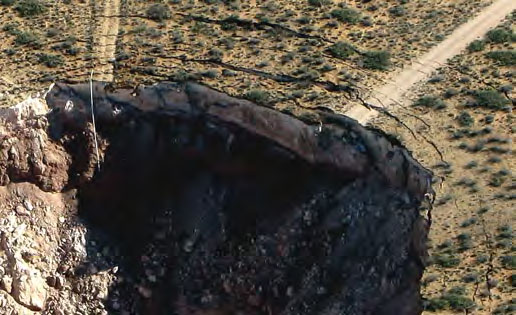
Sinkholes in New Mexico

Photo courtesy of
Lewis Land, National Cave and Karst Research Institute.

Photo courtesy of
Lewis Land, National Cave and Karst Research Institute.
Sinkholes form when the land surface collapses into a void formed in soluble bedrock. Regions where caves and sinkholes form, like the Guadalupe Mountains near Carlsbad, are called karst landscapes. These regions are often internally drained with interconnected subsurface water systems and sinkholes formed over collapsed voids and caverns. Most karst worldwide is in limestone bedrock that has been slowly dissolved by slightly acidic rainwater. This rainwater contains carbonic acid derived from dissolved atmospheric carbon dioxide. The 200 foot deep Blue Hole, in Santa Rosa, is an example of sinkhole or cenote (a water-filled sinkhole in Spanish) that is formed in limestone karst.
However, most of the karst in arid New Mexico is formed over dissolved evaporites. These rocks are soluble in water and are composed of salts remaining after large bodies of saline water evaporate. Gypsum (calcium sulfate) and halite (sodium chloride or common table salt) are both common evaporites in New Mexico, especially in the Permian Basin region in the SE corner of the state. Bottomless Lakes State Park near Roswell is in a region of gypsum karst with many cenotes and sinkholes.
Sinkholes can also form as a result of human activity. Several sinkholes have formed in New Mexico at sites where solution mining of salt was done. Fresh water was injected into subsurface salt beds and the dissolved salt was extracted as brine for use in oil-field operations. As of 2018, several large brine-filled voids are present beneath the city of Carlsbad at the "South Y" (the intersection of US-285 and US-62/180) from one of these brine extraction operations. Funding for remediation as well as mitigation strategies are an active topic of discussion in the area and with several state and federal government agencies.
References
Below are several webpages and publications related to sinkholes, caves, and karst in New Mexico:
Webpages:
- Geologic Tour: Bottomless Lakes State Park
- Virtual Geologic Field Trip to the Permian Reef Complex, Guadalupe and Delaware Mountains, New Mexico-West Texas
- Santa Rosa Lake State Park
Publications:
- Hill, Carol A., 1987, Geology of Carlsbad Cavern and other caves in the Guadalupe Mountains, New Mexico and Texas, New Mexico Bureau Mines Mineral Resources, Bulletin, v. 117, pp. 1-150.
- Hill, Carol A., 2003, Caves and Karst in New Mexico, New Mexico Earth Matters, v. 3, no. 1, pp. 1-4.
- Land, Lewis, 2013, Caves in New Mexico and the southwest, Lite Geology, v. 34, pp. 2-4. [contains classroom exercises about sinkholes].
- Land, Lewis; Lueth, Virgil W.; Raatz, William; Boston, Penny; Love, David L., 2006, Caves and karst of southeastern New Mexico, Land, Lewis; Lueth, Virgil W.; Raatz, William; Boston, Penny; Love, David L., ed(s), New Mexico Geological Society, Guidebook, 57th Field Conference, pp. 1-344. ISBN: 1-58546-092-3
- Land, Lewis; Veni, George, 2012, Electrical resistivity surveys of anthropogenic karst phenomena, southeastern New Mexico, New Mexico Geology, v. 34, no. 4, p. 117-125.
- McCraw, D.J.; Land, L., 2016, Sinkholes: A hidden, real New Mexico geohazard, New Mexico Earth Matters, v. 16, no. 1, pp. 1-6.

